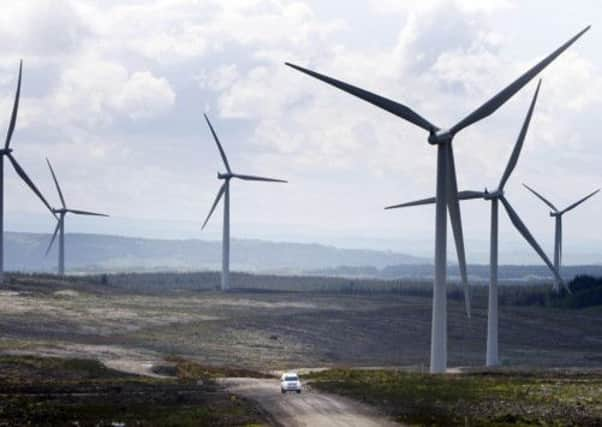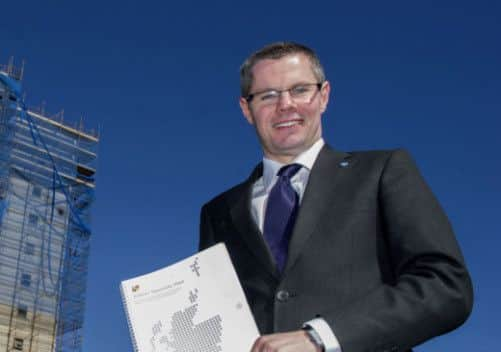Holyrood plan to ban wind farms from scenic areas


• New plans could see wind farms banned from the 19 per cent of Scotland designated as National Scenic Areas or national parks
• Anti-wind farm campaigners ‘disappointed’ by proposals
The latest draft planning policies for the first time prohibit wind farms in the near-20 per cent of the country which has national park or a scenic area status.
Advertisement
Hide AdAdvertisement
Hide Ad

Ministers have also proposed “strengthened environmental protection” against wind energy development for a wider area encompassing Scotland’s wildest and most scenic land, which accounts for about a third of the countryside.
However, the proposals failed to meet the demands of anti-wind farm campaigners, who warned last night such moves would only increase pressure on the rest of Scotland unless more was done to control spiralling development.
The plans, published yesterday, are first time that planning policy has explicitly included wild land with a specific reference to a new, extended wilderness map drawn up by Scottish Natural Heritage in a bid to help safeguard the nation’s landscape.
If the proposals become policy they will mean that in future Scottish councils must take account of areas designated as wild land when deciding wind farm applications.
Under the proposals, in addition to the fifth of areas – 19 per cent – that will see a blanket ban, councils will not be able to approve any development in the overall total of 31 per cent of land given wilderness status unless “any impacts on wild land can be substantially overcome by siting, design or mitigation”.
The proposals in a newly-published draft of the Scottish Planning Policy (SPP) and the third National Planning Framework (NPF3) were welcomed by environmentalists who have long campaigned for tougher measures to restrict the spread of turbines nationwide.
Announcing the draft documents yesterday, planning minister Derek MacKay said they would help forge a better balance in planning decisions between energy needs and the environment.
He said: “The consultation on the National Planning Framework and Scottish Planning Policy will influence development plans across the country for the next 30 years affecting every part of Scotland.
Advertisement
Hide AdAdvertisement
Hide Ad“By providing a clear vision, the proposals will be used to guide future development that will help Scotland achieve its ambitious renewable energy targets and also increase protection for our country’s most environmentally important areas.”
He added: “Scotland is enriched by a high quality environment and many special places to live in and visit.
“These physical assets underpin our economy and our quality of life and that is why we need to ensure developments go in the right place, providing positive benefits for our communities and environment.
“Facilitating much needed new development and investing in modernising our infrastructure, while maintaining and creating high-quality, distinctive, sustainable and healthy places is essential in order for Scotland to maximise its attraction to investors and visitors in a global economy.”
The John Muir Trust welcomed the Scottish Government’s recognition that wild land must from now on be an important factor to be taken into account in planning procedures.
Chief executive Stuart Brooks said: “Along with other conservation and outdoors organisations, the John Muir Trust has waged a long campaign to protect Scotland’s wild and scenic landscapes from industrial-scale development.
“We are pleased that the Scottish Government now recognises the importance of wild land as an important part of our cultural heritage and international profile.”
The new map created by Scottish Natural Heritage extends the number of areas across the country identified as wild land by 17 to 43 areas, boosting the proportion of wilderness from 13 per cent to around 20 per cent of the country’s land mass.
Advertisement
Hide AdAdvertisement
Hide AdSNH said it hoped the map would help ministers and local authorities to do more to safeguard wild land in development planning.
Andrew Bachell, SNH director of operations, said: “Wild land is an incredibly valuable asset for Scotland. It makes an important contribution to our tourism industry and images of wild places also help support Scotland’s world wide reputation as a beautiful and impressive country.
“Like all natural assets this resource must be managed sensitively if it is to be sustained. Our new map will enable planners and developers to take account of wild land, particularly in planning future windfarm and any other large scale developments.”
However, anti turbine groups branded the proposals both damaging and weak.
Linda Holt, spokeswoman for Scotland Against Spin, accused the SNP of “fiddling while Rome burns”.
She said: “There is no doubt that this just adds to the pressure on the rest of Scotland. It’s still open season for the wind industry in Scotland. Any extra discouragement to ‘turbinise’ the 31 per cent of the wildest or most scenic land just ups the pressure on the remaining 69 per cent of Scotland.”
Green energy sector body Scottish Renewables warned that barring wind farm developments across vast swathes of the country could jeopardise Scotland’s ambitious carbon emissions targets.
The Scottish Green Party warned that there was a fine balance to be struck between conservation and green energy needs and criticised further proposals for “unproven carbon capture and storage technology, environmentally-damaging airport expansion and fossil fuel generation at Cockenzie and Longannet”.
Advertisement
Hide AdAdvertisement
Hide AdConservative MSP Murdo Fraser said: “While we are pleased to see some areas set aside for protection, there is absolutely no suggestion the SNP will cool its overall enthusiasm for wind energy.
“This announcement is in effect an admission by the Scottish Government that areas of scenic beauty are not compatible with windfarms.”
A public consultation on the draft policies will run from now until 23 July.
For and against: Are these proposals going to be enough to protect our wild heritage?
Linda Holt: No
PEOPLE fighting inappropriate wind developments across Scotland will be very disappointed. There is very little new here – there are already barriers to building wind farms in national parks, but the issue is that Scotland only has two national parks, and without buffer zones they are still at risk of having 140 metre turbines towering over their boundaries.
We already have a two kilometre setback for turbines from communities but this is only “guidance” and is routinely ignored by wind developers.
A 2.5km setback which is not mandatory is similarly meaningless. What’s the point of protecting wild land from wind turbines when there is no protection against criss-crossing it with giant pylons and infrastructure for offshore wind development?
Measures need to be mandatory or they will not work.
There is no doubt that this just adds to the pressure on the rest of Scotland.
Advertisement
Hide AdAdvertisement
Hide AdIt’s still open season for the wind industry in Scotland. Any extra discouragement to “turbinise” the 31 per cent of the wildest or most scenic land just ups the pressure on the remaining 69 per cent of Scotland – this is where the vast majority of people live and where there are plenty of cherished natural landscapes which windfarms will ruin.
This review of Scottish planning policy amounts to fiddling while Rome burns.
The SNP needs to rethink its energy policy so that it is a policy with only a very small part for wind energy because it is just not reliable. When the SNP has decided what that amount should be it should then decide what Scotland’s capacity for wind is. There is no room for more onshore wind turbines unless we do massive damage, but the Scottish Government will not acknowledge that.
As long as government refuses to acknowledge that Scotland cannot accommodate an infinite number of ever larger turbines, the destruction of our environment will continue, whatever the minister says.
• Linda Holt is spokeswoman for Scotland Against Spin, an anti-wind farm pressure group
Stuart Brooks: Yes
ALONG with other conservation and outdoors organisations, the John Muir Trust has waged a long campaign to protect Scotland’s wild and scenic landscapes from industrial-scale development.
We are pleased that the Scottish Government now recognises the importance of wild land as an important part of our cultural heritage and international profile.
This is the start of a consultation, which as the planning minister has pointed out, will influence development policy in Scotland for the next 30 years.
Advertisement
Hide AdAdvertisement
Hide AdA lot of damage has been done to Scotland’s wild landscapes and ecology over the past 30 years, and if that rate of attrition were allowed to carry on for another 30 years there would be little or nothing left of Scotland’s wild land.
As the Scottish planning policy consultation document spells out, many of our upland, mountain and coastal areas are sensitive to human activity and have little or no capacity to accept new development.
The John Muir Trust has long believed that a special designation would be the most effective long-term safeguard for our wild land, bringing clarity and rigour to the planning process.
In the meantime, however, we will participate in this consultation to help ensure that positive words in support of wild land can be translated into robust action to keep them wild.
We also note that there is currently a number of large-scale developments in the planning pipeline that are located in the heartland of some of our core areas of wild land, as indicated on the mapping published today by Scottish Natural Heritage.
In the light of the content of yesterday’s consultation documents, we would hope that these will now be reconsidered by the relevant planning authorities.
• Stuart Brooks is chief executive of the John Muir Trust.
SEE ALSO